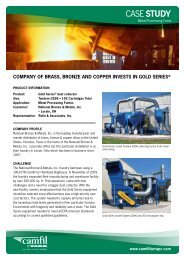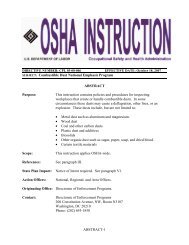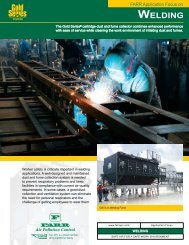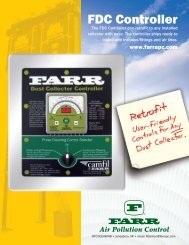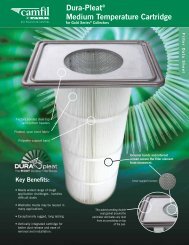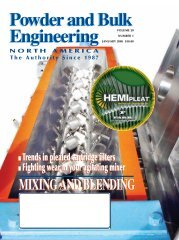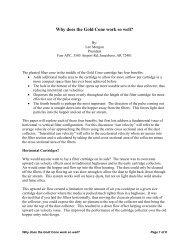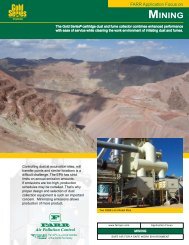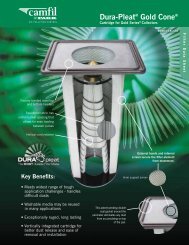How to Make Sure Your Dust Collection System ... - Camfil APC
How to Make Sure Your Dust Collection System ... - Camfil APC
How to Make Sure Your Dust Collection System ... - Camfil APC
You also want an ePaper? Increase the reach of your titles
YUMPU automatically turns print PDFs into web optimized ePapers that Google loves.
WHITE PAPER<br />
<strong>How</strong> <strong>to</strong> <strong>Make</strong> <strong>Sure</strong> <strong>Your</strong> <strong>Dust</strong> <strong>Collection</strong> <strong>System</strong><br />
Complies with Combustible <strong>Dust</strong> Standards<br />
Combustible dust explosions are a risk in many areas of a plant, but one of the most common<br />
locations is the dust collection system. <strong>How</strong> do you know if your dust collection system complies?<br />
What do you do if it doesn’t? Are your employees at risk?<br />
By Tony Supine, Plant Manager, <strong>Camfil</strong> <strong>APC</strong><br />
and Mike Walters, Senior Engineer, <strong>Camfil</strong> <strong>APC</strong><br />
This white paper reviews the OSHA National<br />
Emphasis Program for combustible dust, the NFPA<br />
standards that address how <strong>to</strong> prevent or limit<br />
explosion hazards, how <strong>to</strong> identify these hazards,<br />
and the types of equipment used for explosion<br />
protection. It will also examine the most common<br />
shortfalls <strong>to</strong> compliance and how <strong>to</strong> avoid them.
<strong>How</strong> <strong>to</strong> <strong>Make</strong> <strong>Sure</strong> <strong>Your</strong> <strong>Dust</strong> <strong>Collection</strong> <strong>System</strong> Complies<br />
with Combustible <strong>Dust</strong> Standards<br />
By Tony Supine, Plant Manager, <strong>Camfil</strong> <strong>APC</strong><br />
and Mike Walters, Senior Engineer, <strong>Camfil</strong> <strong>APC</strong><br />
Combustible dust explosions are a risk in many areas of a plant, but one of the most common locations is<br />
the dust collection system. <strong>How</strong> do you know if your dust collection system complies? What do you do if<br />
it doesn’t? Are your employees at risk? What are the hazards and how do you identify them?<br />
The National Fire Protection Association (NFPA) sets standards and codes <strong>to</strong> protect buildings against<br />
fire and explosion risks, and the Occupational Safety & Health Administration (OSHA) is applying these<br />
standards with increasing vigilance. When it comes <strong>to</strong> combustible dust, several standards must be<br />
considered. This white paper reviews the current status of the OSHA National Emphasis Program for<br />
combustible dust, the NFPA standards that address how <strong>to</strong> prevent or limit explosion hazards, how <strong>to</strong><br />
identify these hazards, and the types of equipment used <strong>to</strong> eliminate or control explosion hazards. We<br />
will also examine the most common shortfalls <strong>to</strong> compliance and how <strong>to</strong> avoid them.<br />
The last decade: a look back<br />
In January 2003, an explosion at the<br />
West Pharmaceutical facility in Kings<strong>to</strong>n,<br />
North Carolina killed six workers<br />
and injured 38 others, including two<br />
firefighters. The culprit: inadequate<br />
control of dust hazards at the plant.<br />
Only a month later, in February 2003,<br />
another explosion and fire damaged<br />
the CTA Acoustics manufacturing plant<br />
in Corbin, Kentucky, fatally injuring<br />
seven workers. Investiga<strong>to</strong>rs found that<br />
resin dust, accumulated in a production<br />
area, was likely ignited by flames<br />
from a malfunctioning oven, triggering<br />
the explosion.<br />
The most famous combustible dust<br />
explosion in the past decade – and the<br />
one responsible for re-focusing the<br />
national spotlight on this issue – was<br />
the February 2008 accident at the<br />
Imperial Sugar Company’s Wentworth,<br />
These dust collec<strong>to</strong>rs are equipped with passive and active controls.<br />
Passive controls are an explosion vent and ducting that control the<br />
pressure and flame direction, and a rotary valve that contains the flame in the<br />
hopper. The active control is a chemical isolation system mounted on the<br />
inlet duct. Triggered by a pressure/flame detec<strong>to</strong>r, it will extinguish a flame<br />
front passing through the inlet pipe before it goes back in<strong>to</strong> the plant.<br />
White Paper: <strong>How</strong> <strong>to</strong> <strong>Make</strong> <strong>Sure</strong> <strong>Your</strong> <strong>Dust</strong> <strong>Collection</strong> <strong>System</strong> Complies with Combustible <strong>Dust</strong> Standards 2
Georgia refinery. A dust cloud explosion triggered a fatal blast and fire that killed 13 workers and injured<br />
42 others, generating a s<strong>to</strong>rm of media attention and government scrutiny.<br />
These are by no means the only fatal explosions <strong>to</strong> occur in U.S. manufacturing plants, though they are<br />
the three deadliest <strong>to</strong> be investigated. More recently, in December 2010, two brothers lost their lives in a<br />
chemical explosion at the New Cumberland, West Virginia plant of AL Solutions. And during 2011, three<br />
deadly fires and explosions occurred at a Hoeganaes Corp. plant in Gallatin, Tennessee. Investiga<strong>to</strong>rs<br />
found that accumulations of fine iron powder in the facility led <strong>to</strong> the explosions.<br />
In the U.S. alone in the 25 years between 1980 and 2005, the Chemical Safety Board reported 281<br />
explosions caused by ignited combustible dust. These explosions resulted in 199 fatalities and 718<br />
injuries. Combustible dust explosions over the past decade in U.S. plants are blamed for well over 100<br />
fatalities and hundreds more injuries. Sadly, experts believe these accidents could have been prevented<br />
if the companies involved had followed best practices for fire and explosion protection such as the<br />
methodologies described in this white paper.<br />
Agencies involved<br />
There are three key entities involved in combustible dust issues, each with its own particular area of<br />
responsibility:<br />
NFPA: The NFPA sets safety standards, amending and updating them on a regular basis. As noted, when<br />
it comes <strong>to</strong> combustible dust, there<br />
are several different documents that<br />
come in<strong>to</strong> play, as summarized in<br />
the section directly below. Together<br />
these standards add up <strong>to</strong> <strong>to</strong>tal<br />
protection <strong>to</strong> prevent an explosion,<br />
vent it safely, and/or ensure that it<br />
will not travel back inside a building.<br />
Most insurance agencies and local<br />
fire codes state that NFPA standards<br />
shall be followed as code. Exceptions<br />
would be where the authority having<br />
jurisdiction (AHJ), such as Fac<strong>to</strong>ry<br />
Mutual, specifies an alternative safety<br />
approach which might be even<br />
more stringent.<br />
This dust collec<strong>to</strong>r is equipped with an explosion vent with vertical upblast<br />
deflec<strong>to</strong>r plate. Other safety features include a sprinkler system and filters with<br />
special carbon-impregnated media for static dissipation.<br />
OSHA: It is OSHA’s role, <strong>to</strong>gether<br />
with local authorities, <strong>to</strong> uphold<br />
the standards published by NFPA. In<br />
White Paper: <strong>How</strong> <strong>to</strong> <strong>Make</strong> <strong>Sure</strong> <strong>Your</strong> <strong>Dust</strong> <strong>Collection</strong> <strong>System</strong> Complies with Combustible <strong>Dust</strong> Standards 3
the aftermath of the Imperial Sugar Company<br />
explosion in 2008, OSHA re-issued its 2007<br />
Combustible <strong>Dust</strong> National Emphasis Program<br />
(NEP) outlining policies and procedures for<br />
inspecting workplaces that create or handle<br />
combustible dusts. As defined by OSHA, “These<br />
dusts include, but are not limited <strong>to</strong>: metal dust<br />
such as aluminum and magnesium; wood dust;<br />
coal and other carbon dusts; plastic dust and<br />
additives; bio-solids; other organic dust such<br />
as sugar, flour, paper, soap, and dried blood;<br />
and certain textile materials.” The revised NEP,<br />
which OSHA reissued on March 11, 2008, was<br />
designed <strong>to</strong> ramp up inspections, focusing in<br />
particular on 64 industries with more frequent<br />
and serious dust incidents.<br />
Figure 1: Penalty graph shows fines imposed from commencement<br />
of the OSHA Combustible <strong>Dust</strong> National<br />
Emphasis Program (NEP) in 2008 until Oc<strong>to</strong>ber 2011.<br />
(Image courtesy of www.oshalawupdate.com)<br />
According <strong>to</strong> an Oc<strong>to</strong>ber 2011 OSHA update<br />
on its Combustible <strong>Dust</strong> NEP, since the commencement of inspections under the 2008 program, more<br />
than 2,600 inspections have occurred. More than 12,000 violations were found during this timeframe,<br />
including more than 8,500 which are classified as serious. Federal penalties and fines for these violations<br />
have <strong>to</strong>taled $22,738,909, with nearly another $1,600,000 in state fines. OSHA uncovered a variety of<br />
dust collection violations in these inspections, including dust collec<strong>to</strong>rs that were not equipped with<br />
proper explosion protection devices and systems that were not vented <strong>to</strong> safe locations. (Figure 1)<br />
U.S. Chemical Safety Board (CSB): The CSB is an independent federal agency responsible for investigating<br />
industrial chemical accidents. Staff members include chemical and mechanical engineers, safety experts,<br />
and other specialists with chemical industry and/or investigative experience. The CSB conducts thorough<br />
investigations of explosions like the ones mentioned above – sifting through evidence <strong>to</strong> determine root<br />
causes and then publishing findings and recommendations. The CSB has a wealth of information on their<br />
web site (www.csb.gov), including educational videos depicting how combustible dust explosions occur.<br />
The CSB has become an outspoken advocate of the need for more stringent combustible dust<br />
regulations and enforcement. On February 7, 2012, the fourth anniversary of the Imperial Sugar<br />
explosion, the chairman of the CSB issued a statement in which he applauded the progress made <strong>to</strong> date<br />
in dealing with combustible dust issues. He noted, however: “Completing a comprehensive OSHA dust<br />
standard is the major piece of unfinished business from the Imperial Sugar tragedy…. We believe such<br />
a standard is necessary <strong>to</strong> reduce or eliminate hazards from fires and explosions from a wide variety of<br />
combustible powders and dust.” The CSB has also recommended that the International Code Council,<br />
which sets safety standards that are often adopted by state and local government, revise its standards <strong>to</strong><br />
require manda<strong>to</strong>ry compliance with the detailed requirements of the various NFPA standards relating <strong>to</strong><br />
combustible dust.<br />
White Paper: <strong>How</strong> <strong>to</strong> <strong>Make</strong> <strong>Sure</strong> <strong>Your</strong> <strong>Dust</strong> <strong>Collection</strong> <strong>System</strong> Complies with Combustible <strong>Dust</strong> Standards 4
The role of Congress: Some members of Congress are also advocating<br />
faster action by OSHA <strong>to</strong> implement a combustible dust standard. In<br />
February 2013, Representative George Miller of California, <strong>to</strong>gether<br />
with Representatives John Barrow of Georgia and Joe Courtney of<br />
Connecticut, reintroduced a bill titled The Worker Protection against<br />
Combustible <strong>Dust</strong> Explosions and Fires Act (H.R. 691). If enacted, it<br />
would require OSHA <strong>to</strong> issue an interim standard within one year<br />
of passage and the Secretary of Labor <strong>to</strong> issue a proposed rule 18<br />
months later, with a final rule due within another three years. This<br />
is similar <strong>to</strong> another bill, H.R. 522, which was introduced in 2011 but<br />
never enacted. An earlier bill passed the House in April 2008 but<br />
never went <strong>to</strong> the Senate.<br />
Relevant NFPA Standards<br />
In trying <strong>to</strong> sort through the list of combustible dust standards, a<br />
good starting point for every plant engineer or manager is NFPA 654,<br />
the Standard for the Prevention of Fire and <strong>Dust</strong> Explosions from the<br />
Manufacturing, Processing and Handling of Combustible Particulate<br />
Solids. Simply stated, NFPA 654 is an all-encompassing standard on<br />
how <strong>to</strong> design a safe dust collection system. It is regarded as the<br />
guiding dust document and the most general on the <strong>to</strong>pic, and it will<br />
lead you <strong>to</strong> other relevant documents.<br />
Depending on the nature and severity of the hazard, NFPA 654 will<br />
guide you <strong>to</strong> the appropriate standard(s) for explosion venting and/<br />
or explosion prevention, as follows:<br />
NFPA 68 – Standard on Explosion Protection by Deflagration Venting:<br />
This document focuses on explosion venting – i.e., on devices and<br />
systems that vent combustion gases and pressures resulting from<br />
a deflagration within an enclosure, for the purpose of minimizing<br />
structural and mechanical damage. The current edition, published<br />
in 2007, contains much more stringent requirements than past<br />
editions, essentially elevating it from a guideline <strong>to</strong> a standard.<br />
NFPA 69 – Standard on Explosion Prevention <strong>System</strong>s: This standard<br />
covers explosion protection of dust collec<strong>to</strong>rs when venting<br />
is not possible. It covers the following methods for prevention of<br />
deflagration explosions: control of oxidant concentration, control<br />
of combustible concentration, explosion suppression, deflagration<br />
pressure containment, and spark extinguishing systems.<br />
At the startup of a staged explosion,<br />
explosive dust is injected in<strong>to</strong> the dust<br />
collec<strong>to</strong>r <strong>to</strong> create a flammable cloud.<br />
About 5 milliseconds later, the dust ignites<br />
and the vent opens.<br />
The flame is almost immediately diverted<br />
away from the dust collec<strong>to</strong>r <strong>to</strong><br />
a safe area.<br />
The smoke quickly clears. The whole<br />
event <strong>to</strong>ok about 150 milliseconds.<br />
White Paper: <strong>How</strong> <strong>to</strong> <strong>Make</strong> <strong>Sure</strong> <strong>Your</strong> <strong>Dust</strong> <strong>Collection</strong> <strong>System</strong> Complies with Combustible <strong>Dust</strong> Standards 5
The general document (NFPA 654) also directs the reader <strong>to</strong> appropriate standards for specific manufacturing<br />
industries. The NFPA recognizes that different industries and processes have varying requirements,<br />
and it relaxes or tightens some aspects of its dust standards accordingly. Wood dusts, for example, tend<br />
<strong>to</strong> contain high moisture content that make for a potentially less explosive environment, resulting in a<br />
less stringent overall dust standard for that industry. Conversely, metal dusts can be highly explosive and<br />
subject <strong>to</strong> more vigilant regulation.<br />
The industry-specific standards most commonly employed are:<br />
NFPA 61 – Standard for the Prevention of Fires and <strong>Dust</strong> Explosions in Agricultural and Food Processing<br />
Facilities. This standard covers facilities engaged in dry agricultural bulk materials including grains,<br />
oilseeds, agricultural seeds, legumes, sugar, flour, spices, feeds, and other related materials; facilities<br />
that manufacture and handle starch; seed preparation and meal-handling systems of oilseed processing<br />
plants not covered by NFPA 36, Standard for Solvent Extraction Plants. Examples of facilities covered by<br />
NFPA 61 include but are not limited <strong>to</strong> bakeries, grain eleva<strong>to</strong>rs, feed mills, flour mills, corn and rice milling,<br />
dry milk products, mix plants, soybean and other oilseed preparation operations, cereal processing,<br />
snack food processing, <strong>to</strong>rtilla plants, chocolate processing, pet food processing, cake mix processing,<br />
sugar refining and processing, and seed plants.<br />
NFPA 484 – Standard for Combustible Metals. This standard covers all metals and alloys in a form that<br />
is capable of combustion or explosion, and it outlines procedures that shall be used <strong>to</strong> determine<br />
whether a metal is combustible or noncombustible form. It also applies <strong>to</strong> processing or finishing operations<br />
that produce combustible metal powder or dust such as machining, sawing, grinding, buffing and<br />
polishing. Parts that contain multiple metals or alloys are subject <strong>to</strong> the requirements of the metal whose<br />
combustion characteristics they most closely match. The standard also defines exclusions such as the<br />
transportation of metals or the primary production of aluminum, magnesium, and lithium.<br />
NFPA 664 – Standard for the Prevention of Fire and Explosions in Wood Processing and Woodworking<br />
Facilities. This standard establishes the minimum fire and explosion prevention requirements for facilities<br />
that process wood or manufacture wood products using wood or cellulosic fibers, creating wood chips,<br />
particles, or dust. Examples include wood flour plants, industrial woodworking plants, furniture plants,<br />
plywood plants, composite board plants, lumber mills, and production-type woodworking shops and<br />
carpentry shops that meet minimum requirements for plant size or dust collection flow rates.<br />
Using Performance-Based Codes: In 1995, the NFPA created a Performance-Based (PB) Support Team <strong>to</strong><br />
assist NFPA Technical Committees with the transition <strong>to</strong> performance-based documents. Since that time,<br />
the NFPA has been incorporating performance-based options in<strong>to</strong> its updated standards: The NFPA 654<br />
general dust document first adopted this concept in 2006, with the other more specific combustible dust<br />
standards following suit since that time. Using the newer performance-based codes, solutions no longer<br />
have <strong>to</strong> follow NFPA standards <strong>to</strong> the letter if the variance is backed by full-scale, real-world destructive<br />
test data.<br />
White Paper: <strong>How</strong> <strong>to</strong> <strong>Make</strong> <strong>Sure</strong> <strong>Your</strong> <strong>Dust</strong> <strong>Collection</strong> <strong>System</strong> Complies with Combustible <strong>Dust</strong> Standards 6
Performance-based provisions state specific life safety objectives and define approved methods <strong>to</strong><br />
demonstrate that your design meets these objectives. They give equipment manufacturers and plant<br />
engineers greater flexibility by allowing methods <strong>to</strong> quantify equivalencies <strong>to</strong> existing prescriptive-based<br />
codes or standards, as long as the proposed solution demonstrates compliance.<br />
A performance-based design procedure includes the following steps: (1) establish safety goals; (2) evaluate<br />
all aspects of the facility with regard <strong>to</strong> safety; (3) identify potential hazards; (4) define appropriate<br />
hazard scenarios; (5) establish performance objectives and criteria; (6) select calculation methods (e.g.<br />
computer models); (7) develop a proposed solution; (8) assess the solution; and (9) obtain approval.<br />
Technologies for explosion protection<br />
There are many types of devices and systems used <strong>to</strong> comply with NFPA standards for the explosion<br />
protection of dust collection systems, but they fall in<strong>to</strong> two general categories: passive and active.<br />
Passive systems react <strong>to</strong> the event, while active systems detect and react prior <strong>to</strong> or during the event.<br />
The goal of a passive system is <strong>to</strong> control an explosion so as <strong>to</strong><br />
keep employees safe and minimize equipment damage in the<br />
plant. An active system, by contrast, can prevent an explosion<br />
from occurring. An active system involves much more costly<br />
technology and typically requires re-certification every three<br />
months.<br />
Passive devices include:<br />
• Explosion venting: Designed <strong>to</strong> be the “weak” link of<br />
the dust collec<strong>to</strong>r vessel, an explosion vent opens when<br />
predetermined pressures are reached inside the collec<strong>to</strong>r,<br />
allowing the excess pressure and flame front <strong>to</strong> exit<br />
<strong>to</strong> a safe area. It is designed <strong>to</strong> minimize damage <strong>to</strong> the<br />
collec<strong>to</strong>r and prevent it from blowing up in the event of a<br />
deflagration, thereby reducing the safety hazard. (Figure 2)<br />
• Flameless venting: Designed <strong>to</strong> install over a standard<br />
explosion vent, a flameless vent extinguishes the flame<br />
front exiting the vented area, not allowing it <strong>to</strong> exit the<br />
device. This allows conventional venting <strong>to</strong> be accomplished<br />
indoors where it could otherwise endanger personnel and/<br />
or ignite secondary explosions. (Figure 3)<br />
• Passive float valve: Designed <strong>to</strong> be installed in the<br />
outlet ducting of a dust collection system, this valve utilizes a<br />
Figure 2: A dust collec<strong>to</strong>r explosion vent<br />
designed in accordance with NFPA standards.<br />
Figure 3: Flameless venting device<br />
White Paper: <strong>How</strong> <strong>to</strong> <strong>Make</strong> <strong>Sure</strong> <strong>Your</strong> <strong>Dust</strong> <strong>Collection</strong> <strong>System</strong> Complies with Combustible <strong>Dust</strong> Standards 7
mechanical barrier <strong>to</strong> isolate pressure and flame fronts caused by the explosion from propagating<br />
further through the ducting. The mechanical barrier reacts within milliseconds and is closed by the<br />
pressure of the explosion.<br />
• Back draft damper: A mechanical back draft damper is positioned in the inlet ducting. It utilizes a<br />
mechanical barrier that is held open by the process air and is slammed shut by the pressure forces<br />
of the explosion. When closed, this barrier isolates pressure and flame fronts from being able <strong>to</strong><br />
propagate further up the process stream.<br />
• Flame front diverters: These devices divert the flame front <strong>to</strong> atmosphere and away from the<br />
downstream piping. Typically, these devices are used between two different vessels equipped with<br />
their own explosion protection systems. The flame front diverter is used <strong>to</strong> eliminate “flame jet<br />
ignition” between the two vessels that could overpower the protection systems installed.<br />
Active devices include:<br />
• Chemical isolation: Designed <strong>to</strong> react within milliseconds of detecting an explosion, a chemical<br />
suppression system can be installed in either inlet and/or outlet ducting. Typical components include<br />
explosion pressure detec<strong>to</strong>r(s), flame detec<strong>to</strong>r, and a control panel. This system creates a chemical<br />
barrier that suppresses the explosion within the ducting and reduces the propagation of flame<br />
through the ducting and minimizes pressure increase within connected process equipment.<br />
• Chemical suppression: Whereas chemical isolation is used <strong>to</strong> detect and suppress explosions within<br />
the ducting, chemical suppression protects the dust collec<strong>to</strong>r itself. It is often used, <strong>to</strong>gether with<br />
isolation, when it is not possible <strong>to</strong> safely vent an explosion or where the dust is harmful or <strong>to</strong>xic. The<br />
system detects an explosion hazard within milliseconds and releases a chemical agent <strong>to</strong> extinguish<br />
the flame before an explosion can occur.<br />
• Fast acting valve: Designed <strong>to</strong> close within milliseconds of detecting an explosion, the valve installs in<br />
either inlet and/or outlet ducting. It creates a mechanical barrier within the ducting that effectively<br />
isolates pressure and flame fronts from either direction, preventing them from propagating further<br />
through the process.<br />
• High-speed abort gate: The gate is installed in the inlet and /or outlet ducting of a dust collection<br />
system and is used <strong>to</strong> divert possible ignition hazards from entering the collec<strong>to</strong>r, preventing a<br />
possible explosion from occurring and preventing flame and burning debris from entering the facility<br />
through the return air system. A mechanical barrier diverts process air <strong>to</strong> a safe location. Abort gates<br />
are activated by a spark detection system located far enough upstream <strong>to</strong> allow time for the gate <strong>to</strong><br />
activate.<br />
When planning explosion protection, don’t overlook additional devices and materials that can help<br />
reduce fire risk within the dust collection system. For spark-generating applications, a range of<br />
White Paper: <strong>How</strong> <strong>to</strong> <strong>Make</strong> <strong>Sure</strong> <strong>Your</strong> <strong>Dust</strong> <strong>Collection</strong> <strong>System</strong> Complies with Combustible <strong>Dust</strong> Standards 8
features and technologies are available,<br />
from flame-retardant and carbon<br />
anti-conductive filter media <strong>to</strong> spark<br />
arres<strong>to</strong>rs in the form of drop-out boxes, perforated<br />
screens or cyclone device installed at the<br />
collec<strong>to</strong>r inlet. Fire sprinkler systems may also<br />
be required with some installations.<br />
A dust collec<strong>to</strong>r that uses vertically-mounted<br />
filter cartridges can also reduce fire and<br />
explosion risks. With horizontally-mounted<br />
cartridges, dust becomes trapped in the pleats<br />
in the upper third of the filters (Figure 4). This<br />
Figure 4: Example of horizontally-mounted dust collec<strong>to</strong>r filters trapped dust can burn even if the filter media<br />
is fire retardant. Horizontal cartridges are also<br />
exposed <strong>to</strong> all of the dust entering the collec<strong>to</strong>r, coarse and fine. This leads <strong>to</strong> premature failure from<br />
abrasion and leaks. These leaks can go unnoticed for quite some time while fine combustible dust is<br />
blown in<strong>to</strong> your facility. Vertically-mounted filters use baffle systems <strong>to</strong> segregate much of the dust in<strong>to</strong><br />
the hopper, which reduces the load on the filters and helps eliminate these problems.<br />
Mistakes, misconceptions and pitfalls<br />
A wide range of problems can contribute <strong>to</strong> explosion risk in a facility, but some common denomina<strong>to</strong>rs<br />
exist. Based on years of field experience, the ones we have most commonly encountered are:<br />
Insistence on maintaining the status quo: “I’ve worked here for 30 years and we’ve never had a<br />
problem” is a frequently heard response. This mindset stems in part from a common misconception that<br />
the dust is not explosive because the facility has not had an event– when in fact, the opposite may be<br />
true. In some cases, it may take many years for dust <strong>to</strong> accumulate <strong>to</strong> explosive levels as seen in the CTA<br />
Acoustics event.<br />
To understand the risks, it is necessary <strong>to</strong> review the<br />
five elements comprising what is known as the “dust<br />
explosion pentagon” (Figure 5). They are (1) combustible<br />
dust; (2) an ignition source; (3) oxygen in<br />
the air; (4) dispersion of the dust in sufficient concentration<br />
<strong>to</strong> be explosive; and (5) containment of<br />
the dust cloud within a confined or semi-confined<br />
vessel or area. All five of these elements may exist<br />
in an industrial facility, but all must be present at<br />
the same time for an explosion <strong>to</strong> occur. If there is<br />
no containment, it is still possible for a flash fire <strong>to</strong><br />
erupt if elements #1-4 are present simultaneously.<br />
Figure 5: <strong>Dust</strong> explosion pentagon shows the elements that<br />
must be present for a combustible dust explosion <strong>to</strong> occur.<br />
White Paper: <strong>How</strong> <strong>to</strong> <strong>Make</strong> <strong>Sure</strong> <strong>Your</strong> <strong>Dust</strong> <strong>Collection</strong> <strong>System</strong> Complies with Combustible <strong>Dust</strong> Standards 9
In a closed vessel such as a cartridge dust collection system, an explosion typically begins when an<br />
ignition source enters the dust collec<strong>to</strong>r. This ignition source can come from many things and in most<br />
cases is never identified. When a pulse cleaning event occurs, a suspended cloud of combustible dust is<br />
present in high concentration within the collec<strong>to</strong>r. This completes the five elements of a dust explosion<br />
and initiates the explosion.<br />
Though some incidents involve a single explosion, it is more common for a series of deflagrations <strong>to</strong><br />
occur. The initial explosion can dislodge ignitable dust hidden on overhead surfaces or other areas over<br />
a large area and trigger secondary explosions that can be ignited from the initial explosion or from other<br />
ignition sources. It is these secondary explosions that have his<strong>to</strong>rically caused the majority of injuries and<br />
damage <strong>to</strong> property.<br />
<strong>How</strong> do you know if your facility is at risk? Even if there has never been a problem before, this is no<br />
guarantee of future safety. The level of hazard can change from day <strong>to</strong> day and even from moment <strong>to</strong><br />
moment – whether due <strong>to</strong> the introduction of a new process, a temporary lapse in housekeeping, or a<br />
static electricity discharge caused by improper grounding. It takes ongoing vigilance and management of<br />
change <strong>to</strong> identify conditions in your plant that<br />
might cause a potential safety problem.<br />
Lack of a risk evaluation or hazard analysis:<br />
Failure <strong>to</strong> conduct a hazard analysis is an all<br />
<strong>to</strong>o common oversight. The NFPA states that<br />
a hazard analysis is needed <strong>to</strong> assess risk and<br />
determine the required level of fire and explosion<br />
protection. The analysis can be conducted<br />
internally or by an independent consultant, but<br />
either way the authority having jurisdiction will<br />
ultimately review and approve the findings.<br />
Regarding explosion protection, the first step<br />
in a hazard analysis is determining whether<br />
your dust is explosive. Many commercial test<br />
labora<strong>to</strong>ries offer a low-cost test <strong>to</strong> establish<br />
whether a dust sample is combustible. If the<br />
test is positive, then the explosive index (Kst)<br />
and the maximum pressure rise (Pmax) of the<br />
dust should be determined by ASTM E 1226-10,<br />
Standard Test Method for Explosibility of <strong>Dust</strong><br />
Clouds.<br />
Kst Values of Common <strong>Dust</strong>s<br />
Common <strong>Dust</strong>s Micron Kst Value<br />
Activated Carbon 18 44<br />
Aluminum Grit 41 100<br />
Aluminum Powder 22 400<br />
Asphalt 29 117<br />
Barley Grain <strong>Dust</strong> 51 240<br />
Brown Coal 41 123<br />
Charcoal 29 117<br />
Cot<strong>to</strong>n 44 24<br />
Magnesium 28 508<br />
Methyl Cellulose 37 209<br />
Milk Powder 165 90<br />
Paper Tissue <strong>Dust</strong> 54 52<br />
Pectin 59 162<br />
Polyurethane 3 156<br />
Rice Starch 18 190<br />
Silicon 10 126<br />
Soap 65 111<br />
Soy Bean Flour 20 110<br />
Sulphur 20 151<br />
Tobacco 49 12<br />
Toner 23 145<br />
Wood <strong>Dust</strong> 43 102<br />
Figure 6: Kst values of common dusts<br />
White Paper: <strong>How</strong> <strong>to</strong> <strong>Make</strong> <strong>Sure</strong> <strong>Your</strong> <strong>Dust</strong> <strong>Collection</strong> <strong>System</strong> Complies with Combustible <strong>Dust</strong> Standards 10
<strong>Your</strong> dust collection equipment supplier will need the Kst and Pmax values in order <strong>to</strong> correctly size<br />
explosion venting or suppression systems. Failure <strong>to</strong> provide this information will increase your costs,<br />
since the supplier will have <strong>to</strong> use worst-case estimates of the Kst and Pmax values or may even refuse <strong>to</strong><br />
provide the equipment. The liability <strong>to</strong> the manufacturer and <strong>to</strong> the equipment purchaser is <strong>to</strong>o high <strong>to</strong><br />
ignore the life safety objectives.<br />
The fact is, any dust above 0 Kst is now considered <strong>to</strong> be explosive, and the majority of dusts fall in<strong>to</strong><br />
this category. If OSHA determines that even a very low Kst dust is present in a facility with no explosion<br />
protection in place, a citation will result. This is one of the biggest changes <strong>to</strong> occur with the re-introduction<br />
of the OSHA NEP in 2008. Figure 6 shows the Kst values of a number of common dusts.<br />
Bargain-hunting: Every plant engineer and manager is acquainted with the benefits of basing<br />
purchasing decisions on life-cycle cost – sometimes called “<strong>to</strong>tal cost of ownership” – over choosing<br />
equipment with the lowest price tag. A dust collec<strong>to</strong>r is no exception. A well-designed dust collection<br />
system can pay for itself rapidly in energy and maintenance savings, costing far less <strong>to</strong> operate than a unit<br />
with a low initial price.<br />
A high-quality, heavy duty collec<strong>to</strong>r can also<br />
offer a less obvious advantage in the event of<br />
a combustible dust problem. As documented<br />
both in full-scale testing and field experience,<br />
in the event that a dust explosion occurs in the<br />
collec<strong>to</strong>r, a “bargain” model will more than<br />
likely require <strong>to</strong>tal replacement. A collec<strong>to</strong>r<br />
made of thicker-gauge metal with higher vessel<br />
strength, however, will survive an explosion<br />
and can often continue in service with only the<br />
explosion vent and filter cartridges needing <strong>to</strong><br />
be replaced.<br />
Using non-compliant devices: A close cousin<br />
<strong>to</strong> the bargain-hunting issue involves the use<br />
of non-compliant or uncertified explosion<br />
protection devices. As an example, sometimes<br />
products such as back flap dampers may be<br />
reverse-engineered by suppliers that do not<br />
have any expertise in explosion protection<br />
or have chosen not <strong>to</strong> perform the required<br />
testing <strong>to</strong> satisfy the standards and/or the<br />
performance-based provisions. No testing<br />
exists <strong>to</strong> prove that the device will comply with<br />
current standards.<br />
Pho<strong>to</strong>s of a fac<strong>to</strong>ry taken before and after installation of a dust<br />
collection system show how effectively the collec<strong>to</strong>r cleans up<br />
hazardous dust and fumes.<br />
White Paper: <strong>How</strong> <strong>to</strong> <strong>Make</strong> <strong>Sure</strong> <strong>Your</strong> <strong>Dust</strong> <strong>Collection</strong> <strong>System</strong> Complies with Combustible <strong>Dust</strong> Standards 11
If an OSHA inspec<strong>to</strong>r finds this situation in the field, the plant will have <strong>to</strong> replace the device and may be<br />
subject <strong>to</strong> a fine. Worse yet, if a combustible dust problem should occur, there is no guarantee that the<br />
device will perform as expected.<br />
It is also worth noting, there is no such thing as an “NFPA-approved” device. A supplier may correctly state<br />
that a device “carries CE and ATEX certifications” and/or is “manufactured in accordance with NFPA standards”<br />
– but test data must be available <strong>to</strong> support these claims. Such a device might cost more than its<br />
non-compliant counterpart, but in the long run it can save money, headaches, and even lives.<br />
Housekeeping problems: In an Oc<strong>to</strong>ber 2011 update on the Combustible <strong>Dust</strong> NEP, OSHA reported that<br />
one common violation encountered during inspections involved “hazardous levels of dust accumulation<br />
in the workplaces due <strong>to</strong> poor housekeeping practices”. In the authors’ experience, as a rule of thumb, if<br />
an OSHA inspec<strong>to</strong>r can run his finger across a dusty surface or see a footprint, that is considered a citable<br />
condition.<br />
Diligent cleanup of floors and work surfaces is still not enough if more elevated areas are neglected: <strong>Dust</strong><br />
that accumulates on rafters and other horizontal overhead surfaces, or on <strong>to</strong>p of machinery, is a frequent<br />
culprit. Also, the NFPA recently tightened its definition of hazardous surface dust (in NFPA 654), defining<br />
it as any dust layer of 1/64 inch (0.4 mm) or greater, compared <strong>to</strong> a previous limit of 1/32 inch (0.8 mm)<br />
of dust.<br />
When it comes <strong>to</strong> the dust collec<strong>to</strong>r, a simple but important housekeeping requirement is <strong>to</strong> change<br />
filters when airflow through the system reaches a differential pressure limit as prescribed by the<br />
manufacturer or when the pressure drop across the collec<strong>to</strong>r is negatively affecting the ability of the dust<br />
collection system <strong>to</strong> capture the dust, thus allowing it <strong>to</strong> escape in<strong>to</strong> the facility. Some long-life cartridge<br />
filters available <strong>to</strong>day can operate for two years or even longer between change-outs; but for heavy<br />
dust-loading applications, filter replacement might be considerably more frequent.<br />
Also, use of a listed portable vacuum helps keep the surrounding area free of spilled dust and surface<br />
dust. Use of compressed air <strong>to</strong> control dust is permitted only under certain conditions because it can<br />
increase the hazard by creating a combustible dust cloud.<br />
Another housekeeping misstep is s<strong>to</strong>ring dust in the dust collec<strong>to</strong>r’s hopper. The hopper should<br />
be equipped with a device that discharges the dust in<strong>to</strong> a separate drum or s<strong>to</strong>rage container<br />
after it is pulsed off the filters during the cleaning process. Equally important, this s<strong>to</strong>rage<br />
container must be emptied regularly, or dust can back up in<strong>to</strong> the hopper. <strong>Dust</strong> sitting in a hopper<br />
creates a potential fire or explosion risk, and may also affect performance of the dust collection system.<br />
This will lead <strong>to</strong> loss of airflow which will reduce conveying velocities, allowing build-up of dust in the<br />
ducting and emissions of dust at the process hoods.<br />
Misunderstanding risks involved with “open” style dust collec<strong>to</strong>rs: Some plant managers mistakenly<br />
believe that open type dust collection systems, such as those incorporated in<strong>to</strong> bag-dump stations,<br />
White Paper: <strong>How</strong> <strong>to</strong> <strong>Make</strong> <strong>Sure</strong> <strong>Your</strong> <strong>Dust</strong> <strong>Collection</strong> <strong>System</strong> Complies with Combustible <strong>Dust</strong> Standards 12
downdraft tables and booths, are not a hazard.<br />
While these collec<strong>to</strong>rs admittedly differ from traditional<br />
dust collec<strong>to</strong>rs in that they do not take<br />
the form of a tightly contained vessel, at least four<br />
of the five ingredients of the explosion pentagon<br />
may still be present: combustible dust, an ignition<br />
source, oxygen, and dispersion of the dust in sufficient<br />
concentration <strong>to</strong> pose a hazard.<br />
Thus, there is still a risk of flash fire directed by a<br />
pressure front – a potentially fatal risk, given that<br />
workers are in close proximity in these environments.<br />
If you are using an open type dust collec<strong>to</strong>r,<br />
you must still test and evaluate the combustibility<br />
of the dust and equip the area with fire and/or explosion<br />
protection equipment as required.<br />
The error of over-specification: The problems<br />
described above involve not doing enough in one<br />
way or another. But sometimes plant engineers err<br />
on the side of doing <strong>to</strong>o much – the error of overengineering<br />
or over-specification, which results in<br />
S<strong>to</strong>rage drum prevents dust from backing up in the hopper<br />
and creating an explosion hazard.<br />
explosion protection solutions that may be needlessly expensive and time-consuming <strong>to</strong> maintain and<br />
moni<strong>to</strong>r.<br />
The NFPA uses relatively conservative textbook calculations in its standards for explosion protection<br />
equipment, and justifiably so. <strong>How</strong>ever, as noted above (see performance-based codes), the NFPA also<br />
allows real-world destructive test data <strong>to</strong> be used in place of its own standard calculations, provided the<br />
dust collection supplier can provide adequate data <strong>to</strong> prove that the collection system is designed <strong>to</strong><br />
meet a specific set of criteria for a given situation. The use of real-world destructive test data is thus a<br />
permissible and sometimes overlooked strategy.<br />
An example is actual explosion testing of a dust collec<strong>to</strong>r <strong>to</strong> show that it will stand up <strong>to</strong> anticipated<br />
pressure conditions, instead of using the reduced pressure calculations in NFPA 68. By combining<br />
field testing and full-scale dust collection labora<strong>to</strong>ry test apparatus <strong>to</strong> prove certain assumptions, this<br />
approach might allow you <strong>to</strong> install longer duct lengths in a given application; <strong>to</strong> use a single explosion<br />
vent where multiple vents might otherwise have been needed; or even <strong>to</strong> use explosion venting in place<br />
of a more costly chemical suppression system. Find out if your dust collection supplier can provide realworld<br />
test data <strong>to</strong> assist in a strategy that may help you <strong>to</strong> avoid over-engineering and save on equipment<br />
costs without compromising safety.<br />
White Paper: <strong>How</strong> <strong>to</strong> <strong>Make</strong> <strong>Sure</strong> <strong>Your</strong> <strong>Dust</strong> <strong>Collection</strong> <strong>System</strong> Complies with Combustible <strong>Dust</strong> Standards 13
Conclusion<br />
Not everyone agrees on the best way <strong>to</strong> tackle<br />
combustible dust issues. Some concur with the CSB<br />
position that OSHA needs <strong>to</strong> accelerate efforts <strong>to</strong><br />
produce and enforce its own standard, citing a<br />
long-standing precedent with the grain industry.<br />
Explosions in grain bins used <strong>to</strong> be one of the<br />
biggest safety problems in the U.S. In 1987,<br />
following a series of deadly explosions, OSHA<br />
promulgated a Grain Handling Facilities Standard<br />
that remains in effect <strong>to</strong>day. This standard<br />
has yielded major improvements in<br />
combustible dust safety in these facilities.<br />
According <strong>to</strong> OSHA, “The lessons learned in the<br />
grain industry can be applied <strong>to</strong> other industries<br />
producing, generating, or using combustible<br />
dust.”<br />
Others argue that more stringent and perhaps consolidated<br />
dust standards from the NPFA, diligently<br />
enforced by OSHA and local authorities, would<br />
be preferable <strong>to</strong> a separate OSHA standard. What<br />
This heavy duty dust collec<strong>to</strong>r with explosion vent is designed<br />
<strong>to</strong> survive a combustible dust explosion with minimal damage.<br />
everyone does seem <strong>to</strong> acknowledge is that more drastic action is necessary <strong>to</strong> prevent combustible dust<br />
tragedies from continuing <strong>to</strong> occur.<br />
Until such action is mandated, a certain degree of self-regulation is called for. Managers of industrial<br />
facilities can choose <strong>to</strong> be part of the problem or part of the solution. By following the guidelines in this<br />
article, and securing the help of engineering consultants and equipment suppliers with a proven track<br />
record in combustible dust applications and performance-based solutions, you can minimize risk fac<strong>to</strong>rs<br />
and maximize combustible dust safety in your facility.<br />
# # #<br />
Tony Supine has held numerous positions with <strong>Camfil</strong> <strong>APC</strong> including research and development manager,<br />
technical direc<strong>to</strong>r and currently plant manager. Mike Walters, a registered Professional Engineer with 30<br />
years’ experience in air pollution control and dust collection systems, is a senior engineer with the company.<br />
<strong>Camfil</strong> <strong>APC</strong> is a leading manufacturer of dust collection equipment and part of <strong>Camfil</strong>, the largest air filter<br />
manufacturer in the world. The authors can be reached at (800) 479-6801 or (870)933-8048; email<br />
filterman@farrapc.com; website www.camfilapc.com.<br />
White Paper: <strong>How</strong> <strong>to</strong> <strong>Make</strong> <strong>Sure</strong> <strong>Your</strong> <strong>Dust</strong> <strong>Collection</strong> <strong>System</strong> Complies with Combustible <strong>Dust</strong> Standards 14
References<br />
National Fire Protection Association (NFPA), 1 Batterymarch Park, Quincy, MA 02169; www.nfpa.org.<br />
• NFPA 61: Standard for the Prevention of Fires and <strong>Dust</strong> Explosions in Agricultural and Food Processing Facilities (2013)<br />
• NFPA 68: Standard on Explosion Protection by Deflagration Venting (2013)<br />
• NFPA 69: Standard on Explosion Prevention <strong>System</strong>s (2008)<br />
• NFPA 484: Standard for Combustible Metals (2012)<br />
• NFPA 654: Standard for the Prevention of Fire and <strong>Dust</strong> Explosions from the Manufacturing, Processing and handling of<br />
Combustible Particulate Solids (2013)<br />
• NFPA 664 – Standard for the Prevention of Fire and Explosions in Wood Processing and Woodworking Facilities (2012)<br />
Occupational Safety & Health Administration (OSHA), 200 Constitution Avenue, Washing<strong>to</strong>n, DC 20210; www.osha.gov.<br />
• OSHA Combustible <strong>Dust</strong> National Emphasis Program (Reissued) – Directive Number: CPL 03-00-008; effective date March<br />
11, 2008.<br />
• OSHA Combustible <strong>Dust</strong> Standards, July 2008.<br />
U.S. Chemical Safety and Hazard Investigation Board (CSB), 2175 K. Street, NW, Suite 400, Washing<strong>to</strong>n, DC 20037;<br />
www.csb.gov.<br />
The Library of Congress, 101 Independence Ave, SE, Washing<strong>to</strong>n, DC 20540; http://beta.congress.gov/: H.R. 691: Worker<br />
Protection Against Combustible <strong>Dust</strong> Explosions and Fires Act of 2013.<br />
OSHA Law Update, a Hazard Communication, Epstein Becker Green, 1227 25th Street, NW, Suite 700, Washing<strong>to</strong>n, DC 20037;<br />
http://www.oshalawupdate.com : “2011 Rundown of OSHA’s Combustible <strong>Dust</strong> National Emphasis Program and Rulemaking”,<br />
Amanda R. Strainis-Walker and Eric J. Conn; December 29, 2011.<br />
ASTM International, 100 Barr Harbor Drive, PO Box C700, West Conshohocken, PA, 19428; www.astm.org; “ASTM E 1226-10,<br />
Standard Test Method for Explosibility of <strong>Dust</strong> Clouds”, 2010.<br />
© Copyright 2013 <strong>Camfil</strong> <strong>APC</strong><br />
White Paper: <strong>How</strong> <strong>to</strong> <strong>Make</strong> <strong>Sure</strong> <strong>Your</strong> <strong>Dust</strong> <strong>Collection</strong> <strong>System</strong> Complies with Combustible <strong>Dust</strong> Standards 15



